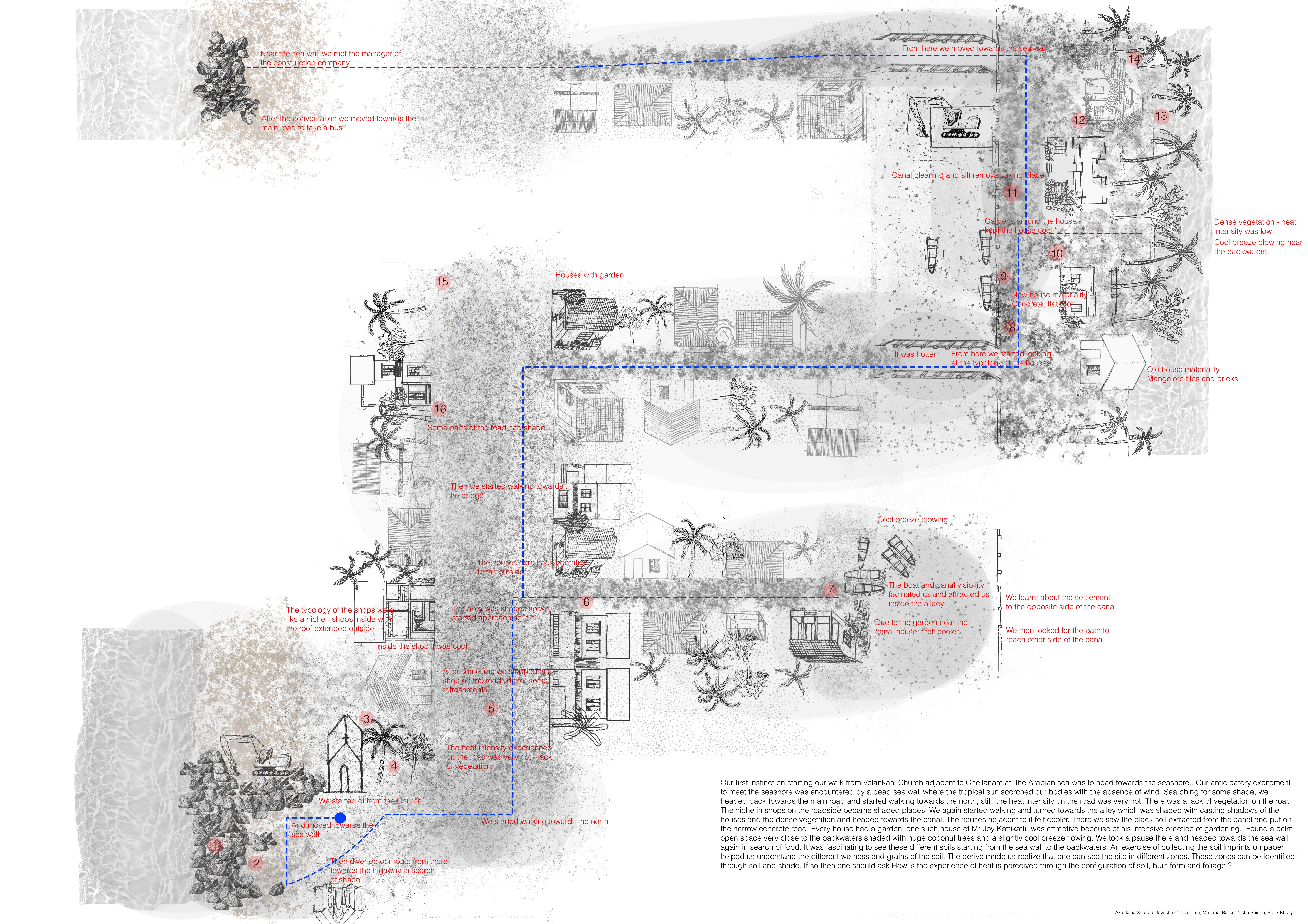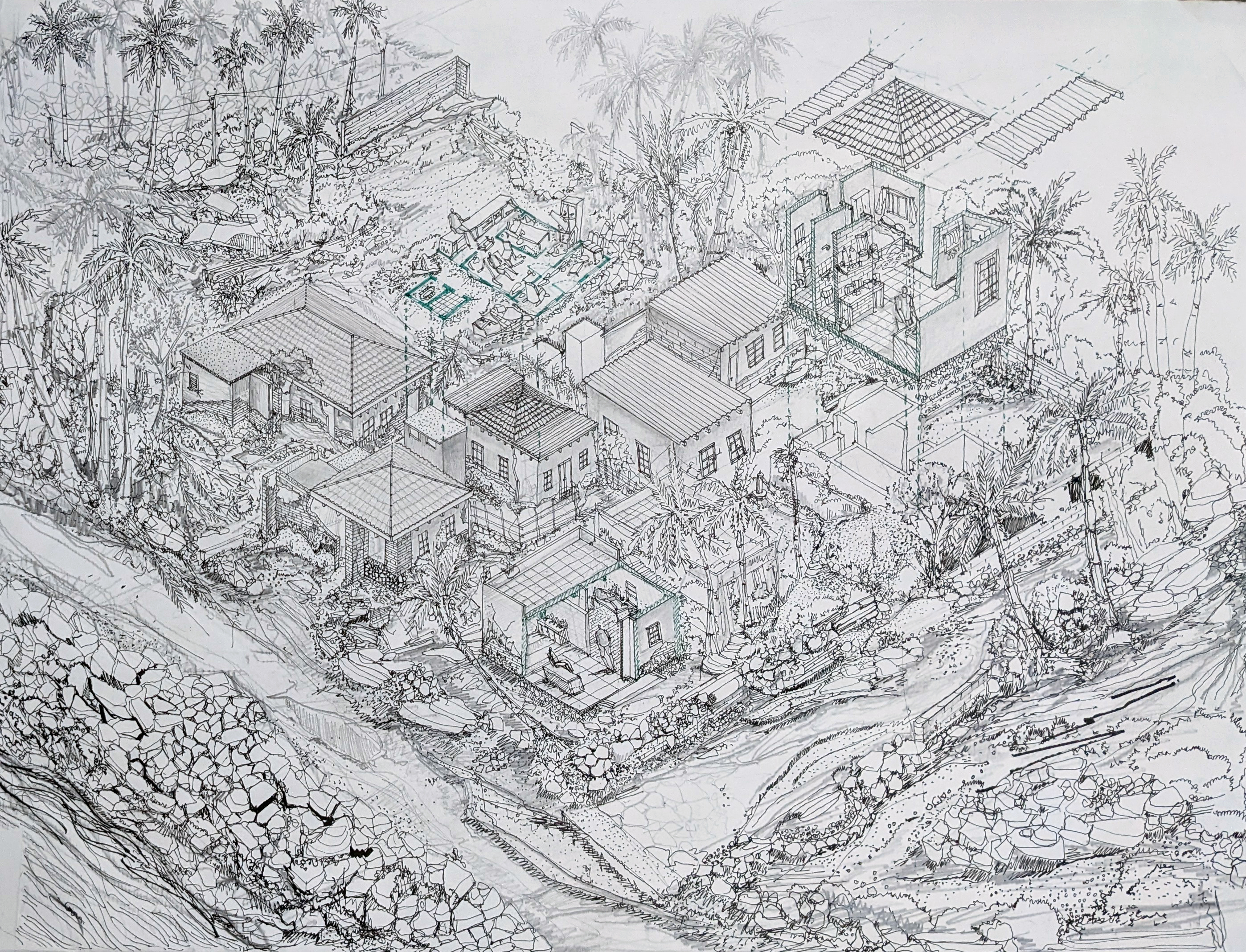Sem 06 / Settlement Studies
Architectural Compositions in Tropical Monsoonal Grounds
Prasad Khanolkar
The ongoing challenges of climate change demand that we rework many of the concepts, methods, practices, and forms of intervention in the field of architecture. These include the large-scale infrastructure projects being implemented across different geographies, the dystopian architectural imaginations, the data-driven modeling practices informing architecture and planning, and inquiries into building techniques and materials for ‘future-proofing’ against climate change. Set in and against this context, this settlement studies studio—Architectural Compositions in Tropical Monsoonal Grounds (ACTMG), is a conceptual and methodological inquiry into the changing relationships between human and other-than-human entities in the context of climate change. Here, ‘architecture’ implies a will and act of constructing relationships between different human and other-than-human entities, while ‘compositions’ refers to the spatiotemporal forms that these relationships take.
The study was conducted in the tropical monsoonal grounds of Chellanam and Kumbalangi—two villages situated on the southern outskirts of Kochi, Kerala. Chellanam is a narrow strip of land located along the confluence of the Arabian Sea and the Vembanad Lake, with households engaging primarily in fishing and small-scale agricultural activities. Kumbalangi is a fishing village known for its chinese fishing techniques, demonstrating craft of making boats and fishing nets and attracts tourists throughout the year. The terrain is primarily composed of brackish water that flows from east and from west through a complex system of estuaries and canals. Over the past few years, this tropical geography has been experiencing different challenges due to climate change, such as frequent floods, cyclones, coastal erosion, drought, and unseasonal heavy rains, among others. These climate change related challenges have triggered shifts across different dimensions of life: changes in built forms, construction techniques, and building materials; changes in economic activities, networks, and practices; changing vegetational and marine lives; increased in and out migration; changes in relationships between communities; and implementation of large-scale infrastructure projects to fight climate change. The aim of this study was to map the different architectural compositions that these relationships are taking using different conceptual and methodological devices.
Dérive: The study involved a week-long fieldwork. The students were divided into eight groups and each group followed a methodical, which began with a dérive or a slow, purposeless walk through the villages. While walking, each group made a live map of the different other-than-human entities that they encountered along the way. Walking as a mapping method draws upon conceptualisations of derive as a drift without predetermined goals that encounter practices of everyday life. Along the way, each group identified different other-than-human entities: terrain, built forms, work practices, religious buildings, gendered entities, plants, animals, insects, fishes, heat, smells, sounds, infrastructures, elements of public life, and so on. At the end of this stage, each group narrowed down on one entity, which they then followed for the rest of the field study. These entities included: Tide, Heat/Shade, Harbour, Vegetation, Edges, Sound, Dilapidated Structures, and Water Bodies.
Finding Shade

Rhythms
The second stage was guided by a question on time: What are the different temporal rhythms (circadian, seasonal, annual, cosmological, everyday, event, long-duree) in the life of this entity? These rhythms were studied through observations, informal conversations, drawings, photographs, and sound recordings. The findings helped understand how the rhythms of each entity are interrelated with those of others. These other entities included insects, birds, different types of vegetation, religious festivals, fish breeding cycles, tidal and lunar cycles, cycles of human migration, market cycles, and so on.

Networks
Next, each group studied the forward and backward linkages that connect their selected entity to other entities. The aim was to study the relationships and interdependencies between different human and other-than-human entities, as well as the form of assemblages that emerge in the process. These networks were documented through observations and informal interviews with different residents. The different networks documented include: economic linkages, infrastructural linkages, environmental dependencies, everyday relationships, gravitational forces, and so on. What emerged through the study is a sense of the nature of relationships between different entities and how they affect each other.

Spatial Affordances
The last stage of the field study focussed primarily on built forms. Here built forms referred not just to buildings, but the spatial interplay between human and other-than human entities, and the forms that this interplay takes in different instances. These included hardening of edges, abandonment and repair, intertidal habitational forms, ordinary practices of homemaking, and microclimatic spaces, among others. These were documented using photographs and different kinds of drawings.

Drawing Architectural Compositions
Post-fieldwork, the documentation (photos, interviews, sketches, videos, and audio recordings) as a whole became the basis to explore the larger question asked in the course: What are the many architectural compositions in the tropical monsoonal geographies of Chellanam and Kumbalangi? These explorations involved using different representational techniques to compose experience, rhythms, networks, and spatial interplay.
The 4x8 grid on the website (link to be embedded) composes this study. Each square on the grid takes the reader to the detailed studies of different entities (from top to bottom): Tides, Water Bodies, Dilapidated Houses, Heat, Harbour, Sound, Edges, and Vegetation, using different methods (from left to right): Dérive, Rhythms, Networks, and Spatial Affordances.

The work from the course can also be found here.